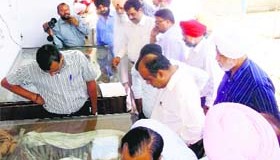Amritsar, Punjab: The DNA testing of the martyrs of the 1857 mutiny, whose remains were dug out from a well (Kalianwala Khu) near Ajnala, would begin soon. The aim would be to establish the identity of the martyrs of the First War of Independence.
While the initial testing would be done by experts from Panjab University (Chandigarh), the final examination and DNA testing would be done at a Hyderabad laboratory.
A committee, comprising members of the Archaeological Survey of India (ASI), Punjab’s Cultural Affairs Department and Panjab University’s experts on forensic science and anthropology, have taken the mortal remains into their possession.
The panel has urged the Punjab Government for providing some space in the university to conduct DNA tests and preparing biological profiles of the martyrs.
“The government is in talks with the university Vice-Chancellor and a decision on this is likely soon,” said Dr Jagminder Singh, Assistant Professor, Department of Anthropology, Panjab University. The department officials had visited the site and taken the remains into their possession.
SS Channy, Principal Secretary, Cultural Affairs and Archaeology Department, Punjab, said he had spoken to the Vice-Chancellor for providing space to the team, and that “hopefully some arrangement would be made soon”. He said the DNA testing was likely to establish the age, gender and physique of the martyrs who laid down their lives during the uprising.
Remains damaged
Dr Jagminder Singh, Assistant Professor at Panjab University, said a majority of the remains had been damaged due to unscientific excavation of the well.
Scientifically, he said, it would have taken around three months to dig out the remains, which otherwise were excavated in a mere three days by the Gurdwara Shaheed Ganj Management Committee.
He said two boxes of bones and teeth, which were in somewhat good condition, had been preserved and deposited with the Department of Cultural Affairs. The excavation team, which worked under the supervision of Surinder Kochhar, a historian, had found 90 skulls, 170 jaws, more than 5,000 teeth, Re 1 coin of East India Company, two Victoria medals, three lockets and some jewellery from the well, dug up in February.
About the martyrs
Around 500 soldiers are said to have revolted at Mian Mir Cantonment in Lahore as part of the 1857 uprising and swam across the Ravi to reach Ajnala. Of them, 218 were killed by the British at Dadian Sofian village, near here, while the remaining 282 were incarcerated in a cage-like room, where many of them died of asphyxiation. The rest were shot dead before their bodies being thrown in the well, which later came to be known as Kalianwala Khu as the British used to call Indians “kale” (black). Several Punjabi NRIs in Britain, besides British Parliamentarians, have urged the UK Government to list out the names of the martyrs who were killed during the 1857 mutiny.
Source: HT
 Sikh Sangat News Celebrating Sikh culture and sharing Sikh voices
Sikh Sangat News Celebrating Sikh culture and sharing Sikh voices

